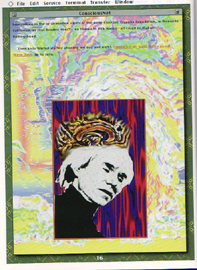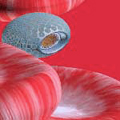The story I just blogged about the nano tech talks at the cryonics conference reminded me that Timothy Leary wrote about Alcor in the book I worked on with him (Surfing the Conscious Nets). (Contrary to popular belief, however, Tim did not freeze his remains.)
I went and dug up the reference to Alcor, just for fun. For those of you with a copy of Surfing the Conscious Nets around, it's on page 16. For the rest of you, I've created a scan here:

I'm sure this is OK with both Last Gasp publisher Ron Turner, who is a friend of mine, and would consider it promotion for the book, and Tim Leary himself, because he told me in 1995 that it was his dream to have all of his works freely available online. A dying wish, if you will.
(Yeah, we're talking everything. So I'm sure he wouldn't mind a few scans.)

On the bright side of the ledger, John Lilly, Jack Nicholson and Michelle Phillips have escaped with their "souls" intact. So far! Several of the lesser known Gabor sisters, rumor has it, had their pretty heads sliced and diced by Dr. Sidney Cohen's gang. Elvis Presley? Who knows? Walt Disney? Janis Joplin? Jim Morrison? Just who exactly still lives frozen in blessed hibernation in the re-animation vaults of the Alcor-CryoCare Cryonics Foundation, in Riverside, California, as Jimi Hendrix does? -- no thanks to Nick Rogue--all credit to Michael Hollingshead.Then Andy Warhol started phoning me day and night. Cryonics is all Andy thinks about these days. So he says.
Hey man, we're all just doing the same thing: crunching numbers, creating submolecular-sized robots with organic cell-like properties, using those robots to re-animate the frozen remains of the deceased...
 | Mark Frauenfelder has written an article for Small Times about the Robert Freitas and Ralph Merkle talks at Alcor's fifth annual Conference on Extreme Life Extension. |
Cryonics Conference Brings Out Nanotech's Extreme Optimists
These nanorobots, Freitas and Merkle believe, could be designed to perform any number of remarkable medical functions. Some could work like superpowered white blood cells that seek out and destroy pathogens. Others could serve as artificial red blood cells, charged with enough oxygen to allow their hosts to hold their breath for up to an hour. Still other nanorobots would repair broken chromosomes, or do a kind of Roto-Rooter on clogged arteries...
The presentations were greeted with enthusiasm by conference attendees, many of whom are members of Alcor, an Arizona-based organization that freezes its recently deceased members in liquid nitrogen in the hopes that they’ll be brought back to life when medical technology becomes sufficiently advanced. Alcor has approximately 1,000 members signed up for “cryopreservation,” and offers either whole-body preservation for $120,000 or “neuro-preservation” (freezing a member’s amputated head) for $50,000...
Freitas is a former research fellow at the Institute for Molecular Manufacturing (IMM), in Palo Alto, Calif., and the author of the book "Nanomedicine." Merkle is the co-inventor of public-key cryptography and a former research scientist at Xerox's Palo Alto Research Center...
There are two hurdles to overcome, he said. First, the technology to assemble components one atom or molecule at a time needs to be developed. Positionally assembled nanotechnology is much different than self-assembled, or “shake and bake” forms of nanotechnology that are currently in use. There have been a few examples of positionally assembled nanotechnology, but they are on the order of attaching a few molecules together at temperatures close to absolute zero, which is minus-459 degrees Fahrenheit. Atomic force microscopes could manipulate structures at the molecular level, but they have a long way to go before they can build something as complicated as a chromosome repair robot...
If and when the process of building tiny robots atom-by-atom is perfected, there’s another hurdle to jump over – replication. Because most nanorobots will be built out of billions or even trillions of atoms, it would be impractical to build them atom-by-atom. Scientists will have to develop methods by which the bots either self-replicate, or are built using massively parallel manufacturing processes. Freitas refers to this as “exponential assembly.”
Here is the full text of the article in case the link goes bad:
http://www.smalltimes.com/document_display.cfm?document_id=5148
CRYONICS CONFERENCE BRINGS OUT NANOTECH'S EXTREME OPTIMISTS
By Mark Frauenfelder
Small Times Correspondent
An artificial white blood cell, or "microbivore," heads off a pathogen at the pass in this artist's conception of nanotech's future.
NEWPORT BEACH, Calif., Dec. 6, 2002 – At Alcor's fifth annual Conference on Extreme Life Extension here recently, two well-known scientists presented their visions for the far-out future of nanotechnology.
Ralph Merkle and Robert Freitas of Zyvex Corp., a nanotechnology and MEMS research and development company in Richardson, Texas, asked the 200 or so conference attendees to imagine a time in the coming decades when doctors will routinely inject billions of nanosized robots into patients’ bodies.
These nanorobots, Freitas and Merkle believe, could be designed to perform any number of remarkable medical functions. Some could work like superpowered white blood cells that seek out and destroy pathogens. Others could serve as artificial red blood cells, charged with enough oxygen to allow their hosts to hold their breath for up to an hour. Still other nanorobots would repair broken chromosomes, or do a kind of Roto-Rooter on clogged arteries.
The presentations were greeted with enthusiasm by conference attendees, many of whom are members of Alcor, an Arizona-based organization that freezes its recently deceased members in liquid nitrogen in the hopes that they’ll be brought back to life when medical technology becomes sufficiently advanced. Alcor has approximately 1,000 members signed up for “cryopreservation,” and offers either whole-body preservation for $120,000 or “neuro-preservation” (freezing a member’s amputated head) for $50,000.
Alcor froze the late ballplayer Ted Williams after he died of cardiac arrest in July. His corpse was flown from Florida to Alcor’s headquarters in Scottsdale, where it was immersed in a giant bottle of liquid nitrogen at minus-320 degrees Fahrenheit. Alcor members hope that nanomedicine can be employed toward extending their lifespans as well as repair cellular damage that occurs during the freezing process.
Freitas is a former research fellow at the Institute for Molecular Manufacturing (IMM), in Palo Alto, Calif., and the author of the book "Nanomedicine." Merkle is the co-inventor of public-key cryptography and a former research scientist at Xerox's Palo Alto Research Center.
Both showed the audience a series of artistic renderings depicting nanoscale machines navigating through human blood vessels. Freitas also ran an animated computer graphic of an artificial white blood cell, which looked like a metallic football with a tunnel running through its longitudinal axis. When the nanorobot came in contact with a germ, tiny grapplers rose from its surface, grabbing the germ and passing it hand over hand to the nanorobot’s “mouth.” As soon the robot ingested the pathogen, the mouth snapped shut. A few seconds later, the harmless remains of the devoured germ passed through the bot’s posterior opening.
Sound far-fetched? Maybe, but the only way to really find out whether nanomedicine is achievable is give it a try. In a phone interview following the conference, Freitas stressed that nanomedicine based on mechanically synthesized nanorobots is “at least 10 to 20 years away.”
There are two hurdles to overcome, he said. First, the technology to assemble components one atom or molecule at a time needs to be developed. Positionally assembled nanotechnology is much different than self-assembled, or “shake and bake” forms of nanotechnology that are currently in use. There have been a few examples of positionally assembled nanotechnology, but they are on the order of attaching a few molecules together at temperatures close to absolute zero, which is minus-459 degrees Fahrenheit. Atomic force microscopes could manipulate structures at the molecular level, but they have a long way to go before they can build something as complicated as a chromosome repair robot.
Zyvex is one of a very few number of companies conducting research into positionally assembled nanotechnology. Freitas estimates that Zyvex dedicates between 10 and 20 percent of its resources in this area, and spends the majority of its resources on MEMS-level assembly processes.
If and when the process of building tiny robots atom-by-atom is perfected, there’s another hurdle to jump over – replication. Because most nanorobots will be built out of billions or even trillions of atoms, it would be impractical to build them atom-by-atom. Scientists will have to develop methods by which the bots either self-replicate, or are built using massively parallel manufacturing processes. Freitas refers to this as “exponential assembly.”
With these two big barriers blocking the road to medical nanorobots, few investors are willing to gamble on such an idea. Freitas admits that investors willing to look this far ahead are “rare,” and that it’s not likely for there to be a lot of “bubbling enthusiasm” in investor and research communities until someone can offer solid experimental demonstrations of positional assembly.
Naturally, Freitas would be delighted if Zyvex ends up being the company that cracks the weighty problems of sophisticated nanomedicine. It’s not going to be easy, he said, “but the result is very much worth it. It’s a very powerful technology once you have the ability to do it.”
I still don't really understand it completely, but something pretty cool happened over in Australia with regard to the hypothetical possibility of being able to someday transport matter instantaneously.
See the New Scientist article by :
Quantum Teleportation Technique Improved.
Molecular-transistors are here. (Hee-haw!)
Now just what the heck does that mean? :-)
Well, it's kind of a long story, but the synopsis below does a pretty good job of summing it up.
Here's this nice explanation (thanks ACM News service) along with a link to its longer version:
The Nanotube Computer,
by David Rotman at the MIT Enterprise Technology Review
(Technology Review (03/02) Vol. 105, No. 2, P. 36; Rotman, David)
Carbon nanotubes have the potential to significantly change the world of electronics over the next decade. Phaedon Avouris of IBM Research says that nanotubes can be fashioned into transistors that are superior in performance to silicon-based transistors. Molecular transistors based on nanotubes or nanowires could increase the number of devices that can be installed on a chip, boosting computer memory and logic circuits. Nanotubes are very compatible with existing semiconducting materials, and the possibility exists that they can be combined with silicon technology, although the dual metallic/semiconducting nature of nanotubes can complicate the fabrication of logic devices. They are also seen as an eventual replacement for silicon once it reaches the threshold of Moore's Law. Meanwhile, companies such as Nantero are pursuing nanotube-based nonvolatile memory, which could eliminate the need for people to repeatedly boot up their computers and supplant dynamic random-access memory (DRAM). Nanotubes can also emit electrons at low voltages, and this property forms the basis of thin but cheap flat-panel displays that project a high-quality image; Motorola and other electronics firms are competing to build a working nanotube display. Nanotube research has helped raise the profile of nanoscale materials and their commercial applications, which could include minuscule biological sensors and light-emitting diodes, fuel cell electrodes, and many others.
Scientific American takes a whack at explaining nanotechnology.